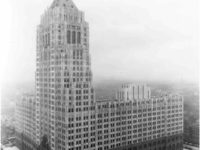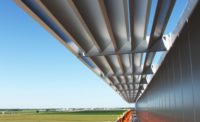Section Cut: The Integration of Operable Sunshades

Dynamic facades, ones that not only provide for the high-performance enclosure of a building but through innovative design react to the environmental demands, are part of the continuing evolution of modern architecture. In this SCGMA Case Study, we look at a complex façade and how the integration of operable sunshades enhanced energy performance as well as greater occupant comfort.
A Non-Traditional Design
Designed by Morphosis Architects, the Emerson College LA Campus is a 10 story, 107,000 square foot academic and housing project on Sunset Boulevard in Hollywood. The $110 million facility brings student interns to LA each year to work in the media and film industries. The building incorporates 188 student dormitory rooms for 217 students with 4 faculty apartments, as well as classrooms, video/film production labs, screening rooms, offices, a fitness center, café, retail, and 3 levels of below grade parking.
The two residential towers present unique façades to the east and west, as an automated system controls the horizontal sunshades based upon the temperature and angle of the sun. Behind the sunshades, a high-performance glass curtain wall features operable windows in the dorm rooms for natural ventilation. At the inner side of the student residences and common areas, a metal panel scrim curves along to provide further shading and also to conceal plaster walls for the housing entries.
The space between the towers and the connecting roof structure provides the feeling of being on stage. The classrooms and teaching facilities intertwine at the center within the open space and create terraces that promote a social environment. These structures are unpredictable in shape, creating an appealing composition of curves, angles, and inverted sloping walls. Walls are clad in rainscreen aluminum panels, while curtain walls maximize vision area with high span stick framed openings and irregular glass shapes.
Completed in 2014 by Hathaway Dinwiddie Construction, the building achieved LEED Gold certification.
Delivery
From Design-Development, the Hathaway Dinwiddie/Morphosis team chose Design-Assist as a delivery method for the façade systems. After receiving pricing and interviewing exterior wall contractors, Walters & Wolf was selected to provide the curtain walls, storefronts, glass guardrails, and operable louvers while Zahner was chosen for the articulated panel system, intricate metal scrim, and other louvers.
Unique Glass Facade Challenges
“The geometry of the academic area curtain walls required close coordination with the Zahner panel wall at the perimeter,” said Walters & Wolf Project Manager Rodrigo Morales. Dimensional control was established by the architect. “Separation by sealant joint was used typically to simplify the interphase and transitions, allowing the different systems to move independently.” Framing systems for the academic area were shop fabricated, then packaged and shipped to the site for field assembly.
“The typical tower curtain walls were twin span units with 10’-0” floor to floor heights, attached to the structure via aluminum anchor clips and embedded channels. The operable sunshade attachment was designed to anchor directly to the curtain wall to avoid penetrations for the attachment to the structure, though electrical penetrations were necessary for the ultimate power to the system. The curtain wall was designed to take the loads transmitted under the different sunshade positions,” said Morales. Operable windows were shop installed into the unitized curtain wall panels and set as complete glazed units.
The operation of the horizontal blades was tied to the building management system and provided optimum shading based upon the time of day. The sunshade blades are mounted on pivots that are actuated by a lever arm (noted as 14) and attached to the motor shaft. The electrical portion of the operable sunshades required compliance with NEC for LA Building Department approval. The system wasn’t UL Listed as an assembly when fabricated, but compliance was obtained during installation through on-site modifications.

Mock-Up, Field Installation
The curtain wall performance mock-up included the operable sunshades and the glazed curtain wall with operable windows, to validate the operation and weather tightness. The sunshade system mock-up included the motors to allow the panels to be operated.
In order to meet the construction schedule requirements, all products other than the main entry stair glass guardrail were prefabricated based upon agreed construction tolerances.
“The installation of the unitized curtain wall followed by the sunshade was critical due to the amount of work it represented. Interior finishes followed directly behind the curtain wall. The initial plan was to use mast climbers to install the sunshades, but eventually, the installation was done with swing stages after the mast climber rental company failed to provide the adequate equipment,” said Morales.
Lessons Learned
In regards to what worked well, the consensus is that the curtain wall installation with the shop installed operable windows, along with dimensional coordination to produce metal and glass for the academic walls had few complications. In regards to what could have worked better, in hindsight, the approval process of the operable sunshade system would be notable.
From Walters & Wolf’s perspective, “We learned a great deal of what and what not to do regarding the operable sunshade system procurement and approval,” said Morales. In the end, we believe that the anticipated project goals were met.
As stated by the exterior wall consultant (Jon Weir, JA Weir Associates), “This was a complex façade project that went together seamlessly, due to an architectural firm that was willing to sit down and roll up their sleeves anytime that it was needed, and a highly skilled group of contractors who collaborated as well as anyone on the design team could ask.”
This submission for Section Cut is courtesy of Southern California Glass Management Association.
Looking for a reprint of this article?
From high-res PDFs to custom plaques, order your copy today!




